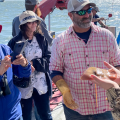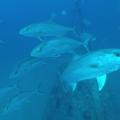Trophy Bass Management Basics
Trophy Bass Management Basics
If you have reviewed the page on how you can manipulate balance in ponds, you will know that the secret to growing big bass is to have fewer bass and more prey. In fact, there are four factors that go into growing trophy fish:
- Growing season
- Genetics
- Age
- Food
1. Growing season determines maximum possible size of fish, but unless you are willing to move, it is not something you can control. The biggest largemouth bass are caught between about 25 and 35 degrees latitude, as the growing season at this latitude is ideal.

2. Genetics play a role in fish size, but it is more dependent on individual fish than on subspecies. Florida bass grow larger at latitudes from 35 degrees N and south, although they may be harder to catch. Northern largemouth bass do better at higher latitudes. Hybrid “F1” bass combine the best traits of both, but their offspring may not be nearly as good. However, management is much more important than genetics.
3. As a rule, fish typically get larger as they get older, so age is an important factor. This does not mean you need to let every bass grow up, as not all bass are created equal—but they all eat prey. Harvesting small bass is critical to freeing up food for larger fish. Remember: The way to a trophy bass is through her stomach.

Male bass do not get nearly as big as female bass. A trophy male might be 5 pounds. If you can tell males and females apart, especially in the spring, take out males. Also, take out skinny fish, small fish, deformed fish, etc. A harvest rate of at least 30 to 35 pounds per acre per year is needed, maybe more. Plus, you should take out a few bigger fish (14 to 16 inches) than the basic management approach. This will make prey available to the healthy, fast-growing fish that remain.

4. That brings us to food- the most important consideration for growing big bass. If you can effectively keep unlimited food available to your fish, they will grow fast and large. There are two ways to do this: decrease competition for prey and increase production of prey.
We have already discussed how to use harvest of small bass and inferior fish to reduce competition for prey. We have also discussed ways to manipulate the pond’s water quality using lime and fertilization to double or triple productivity. These are the basic steps for funneling more prey resources into fewer bass, allowing them to grow larger. We have not yet discussed feeding or alternative prey species
The research is inconclusive on how feeding bream affects bass growth. Theoretically, feeding bream should increase bream production, which translates into more bass. However, this has not been observed consistently in practice. Alternatively, stocking feed-trained bass and feeding them consistently is an effective way to grow fish, although it is an investment many pond owners may not be willing to make.
Another approach is stocking new prey species to make more prey available to bass. Here are some pros, cons, and approaches of each potential species, with their relative rank in preference. Check local laws to make sure these species are legal before introducing.
- Threadfin shad. Threadfin shad are an ideal prey species for bass in ponds in the Deep South. The species reproduces quickly, provides very high-energy nutrition, and does not get too big for the bass to eat. It will compete with bream for prey, so it is best for ponds where only bass management is important. Unfortunately, threadfin shad die if ponds ice over, so they are not an option to the north. They are usually stocked by the tank-load, and restocking is only necessary if a winter kill occurs.
- Gizzard shad. This is a larger shad than threadfin shad. It shares the same beneficial characteristics, except it can outgrow the ability of bass to eat it. Thus, it is possible for ponds to contain large numbers of gizzard shad that cannot be eaten. This option is best for ponds with large numbers of bass 6 pounds and larger. It is much more cold-tolerant and should persist indefinitely after stocking.
- Rainbow trout. Trout have received a lot of interest in recent years, as they provide a high-energy food to bass as well as an alternative fishery, at least for part of the year. In warm climates, they are stocked in the fall to feed fish over winter, but they die when water warms up in the spring. They may persist in northern climates. Trout do not reproduce in ponds and must be restocked. They tend to be expensive, so this option is not feasible for many pond owners.
- Tilapia. Tilapia are not legal in some states, including Mississippi. Where they are legal, they are stocked in the spring, reproduce all summer, and die in late fall. They can provide a lot of food to bass over summer months, and large fish can be dipped up and eaten in the fall.
- Golden shiner. This species can persist in most ponds but does not usually reproduce enough to lead to trophy bass. Adult golden shiners usually get an ovarian parasite, Ovipleistophora ovariae, after their first spawn that makes them sterile. There may be instances where they are useful, but they are not as often recommended as they once were.
- Fathead minnow. This species is widely available and often sold as prey for bass. Unfortunately, this species is quickly eliminated by bass, usually before they can reproduce. In order to actually see a difference in bass growth, you would have to stock an incredible number of fatheads. Because of this, fatheads are good for starting new ponds but are not very useful once bass have established.
News
BILOXI, Miss. -- The Southeast has some of the most commercially and recreationally valuable fisheries in the United States.
Fisheries experts at Mississippi State University and other research institutions are conducting an $11.7 million study of the greater amberjack, an important recreational and commercial species in the South Atlantic and Gulf of Mexico that is threatened by overfishing.
Grandpa cast the jig and cork to the center of the pond and handed it to Lucy. “Now, start reeling in slowly,” he said.




